Radioastron rips templates
Today, exactly two years ago, the Spektr-R spacecraft is in orbit. And today we can confidently say that Radioastron is the most successful unmanned space project of Russia of the 21st century.
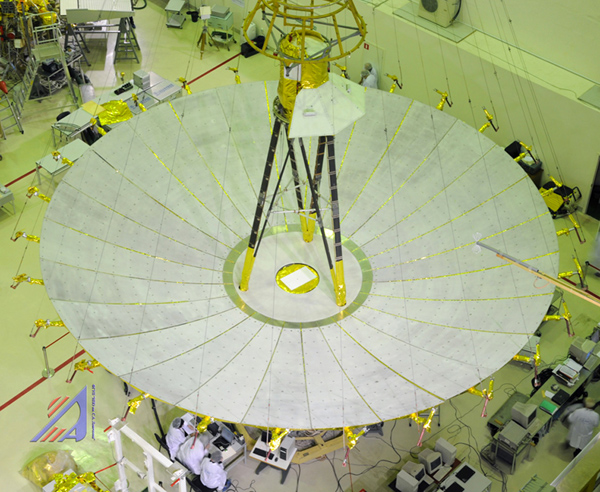
After the first observations, a year and a half has passed. All this time the telescope was occupied by an early scientific program. In fact, the first studies consisted in the fact that scientists determined the limits of the capabilities of RadioAstron and set such scientific tasks that were of high scientific importance and the probability of success. This program was coordinated by the Astro-Cosmic Center (ASC) of FIAN, the program manager Yu.Yu. Kovalev, performed by international groups of scientists with the leading role of the ASC.
Yury Yuryevich helped in the preparation of this material, for which he thanks a lot.
')
What did scientists learn during the work of the Radioastron project?
Firstly, they learned the capabilities of their apparatus, and secondly, they learned what knowledge, in the future, are able to provide these opportunities.
If someone has difficulties with understanding the work of Radioastron, I recommend reading the previous article on this topic, where I tried to explain the basic principles of radio interferometry with super-long bases.
In the course of scientific research, scientists build theoretical models, or simply reasonable assumptions, which are designed to fill gaps in knowledge. These models are based on already known facts and mathematical calculations, and each newly discovered fact makes it possible to double-check the accuracy of the model and the accuracy of the calculations. So, theoretical models made it possible to predict what results Radioastron would produce on bases up to 10 Earth diameters - about 130 thousand km. What will happen next, no model could predict - it could only be verified.

Scheme expert.ru ( large size on the site ).
There were several questions. The first is in the brightness and compactness of distant galaxies. If the nuclei of galaxies are not compact enough, with a high angular resolution of Radioastron, we would not “see”. One noise. The second important question is in the properties of the interstellar medium - its density and structure. Despite the illusion of emptiness, almost all the space in our Galaxy is filled with gas and dust. Although their share is insignificant, at large distances they begin to affect the radio emission passing through them like the earth's atmosphere. This effect is the stronger the longer the wave on which the observation is made. It was assumed that compact objects, which are still possible to distinguish at a length of 1.3 and 6 cm, at 18 and 92 cm will already appear blurry. Just as you can take an optical telescope of any power, but in the fog, he still does not see anything.
The early scientific program received positive results, for a wave of 92 cm, on the bases of an interferometer with a distance of up to 20 Earth diameters (that is, two times better than predicted).
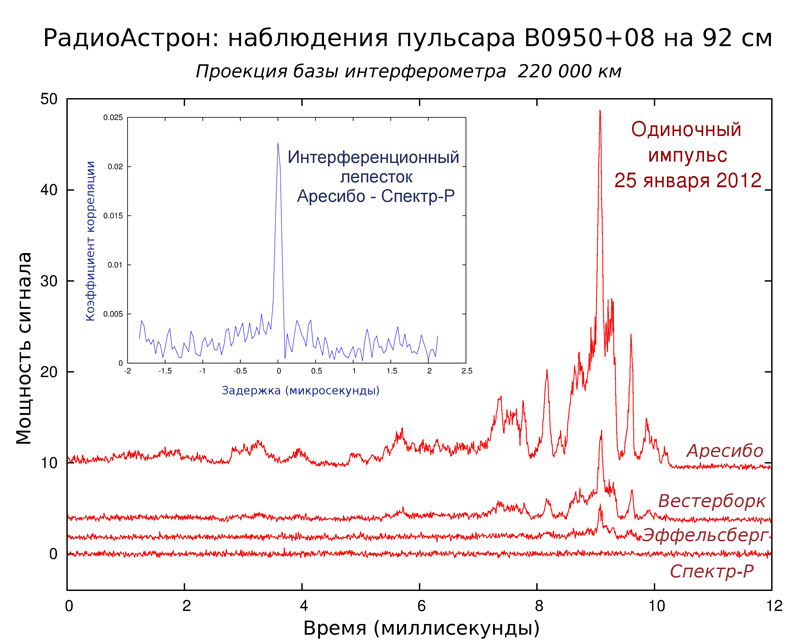
This is the very signal. Please note that the Spektr-R space telescope practically does not register a pulse, but paired with Arecibo, they give a clearer signal, i.e. provide higher resolution, which is the meaning of the project "Radioastron".
Image prepared by ASC LPI
For a wave of 18 cm, data were obtained at a distance of up to 16 Earth diameters. 19 diameters for a wave of 16 cm and 8 diameters on a wave of 1.3 cm. It does not even matter what the results were at these distances, how much the distances themselves are. Waited "fog", but it was not there. More precisely, the fog was, but not with the properties, as predicted by the theory. Not at all the structure.
A separate subject of pride of our astrophysicists and engineers is the angular resolution, which they received at a wavelength of 1.3 cm at the bases of the ground-space interferometer in 8 diameters of the Earth. The result is 27 microseconds of arc or angular microseconds. This is the highest resolution that has been obtained by any instruments in the entire history of human observations of the Universe. To better understand the magnitude of this figure, compare with the results of Hubble. Let me remind you that its resolution is 0.05 arc seconds. Radioastron showed 0.000027.

But one cannot oppose these two instruments, since they are too different. They work in different ranges, and on different principles build images. Therefore, to say “Radioastron is cooler than Hubble”, is equivalent to the phrase: “Our crane is faster than their bulldozer”. Figuratively telescopes can be compared with construction equipment: each device is busy with its own business, but together they build one road to knowledge.
Now, about the results of observations .
Radioastron dedicated much of its working time to quasars. Quasars are high density, active galaxies that form around supermassive black holes. The light of an accretion disk (usually studied in the X-ray range) reaches us, in which stars and interstellar gas gather under the action of the force of attraction of a black hole. Under the pressure in the disk, colossal energy is released, which we perceive as electromagnetic radiation. Internal processes form the most powerful jets of matter from the poles of rotating black holes. These flows are called jets or relativistic jets, since the speed of propagation of matter from them comes close to the speed of light, which is possible only when exposed to the most powerful energy.
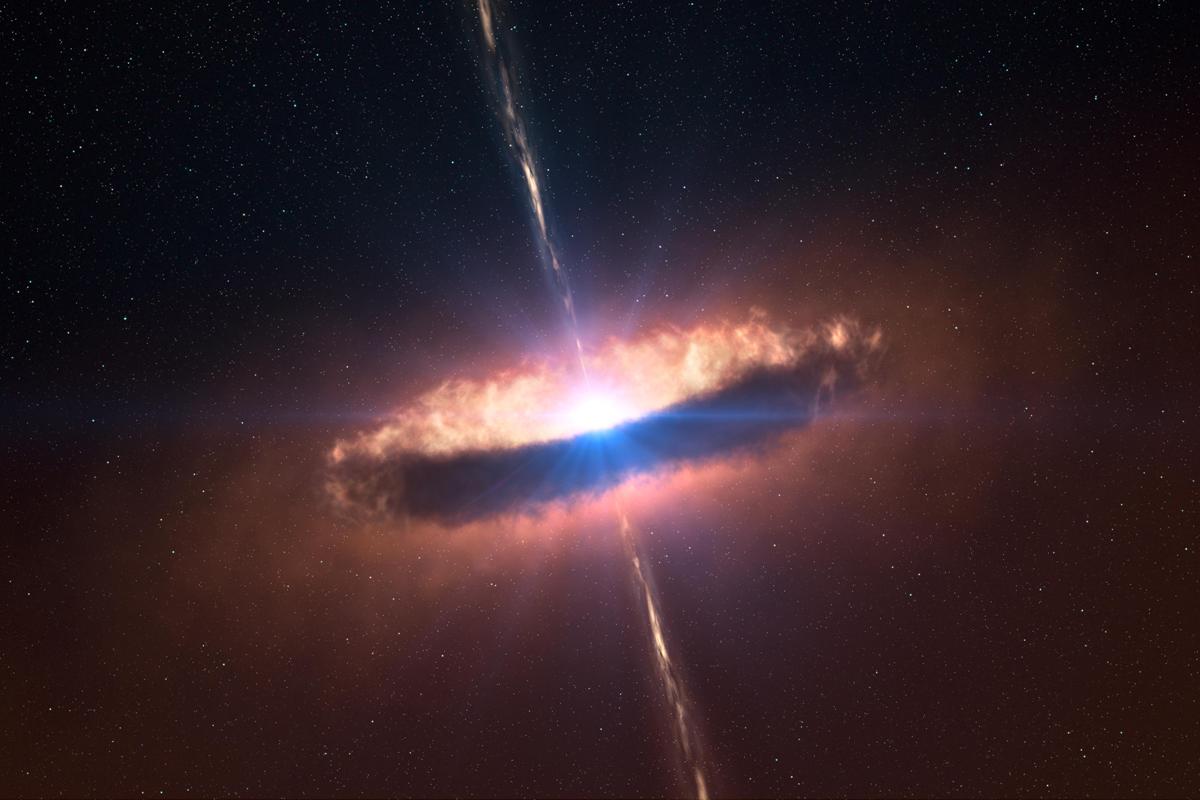
Quasars are located at significant distances of billions of light years from us. If they were at least millions of light years away, the nights would be much brighter. But I wouldn’t regret the remoteness of quasars - if the Solar System got into the jet, it would quickly disinfect it and no bunkers would save us.
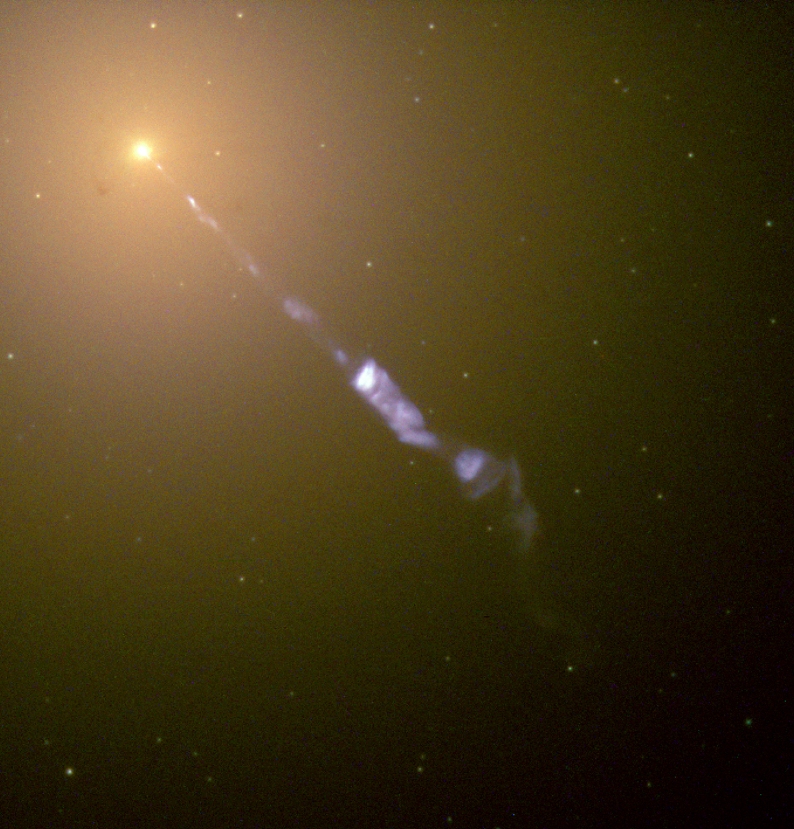
This is not a quasar, but a jet from the center of one of the largest galaxies M87 . Photo Hubble.
Quasars discovered in the late 50s. Twentieth century, but today scientists are wondering what is happening in their center.
According to the speed of variability of their brightness, it was suggested that the core of one of the active galaxies should be no larger than the solar system, but they could not determine the exact scales before. Until Radioastron arrived.
In general, the variability of the brightness of a quasar can also arise from reasons beyond its control — for example, from a gas-dust cloud that lies between us and it. But if it flickers at the same time in all or in several ranges, then internal causes are most likely. One of these objects, whose radiation variability in the optical and radio bands coincided, had previously been carefully observed from the Earth and concluded that it was not about interplanetary dust, but internal processes.
It was him who was chosen as a "shooting" for "Radioastron". Quasar 0716 + 714 was the first active galaxy mapped with the highest accuracy previously unavailable. It turned out that the diameter of the "nozzle" from which the relativistic jet takes off is about one light year. It is curious that these observations disproved the early hypothesis that the rapid variability of the radiation of the galactic nucleus is associated with internal processes. That is, once again, “Radioastron” violated the early model and forced scientists to look for another solution.
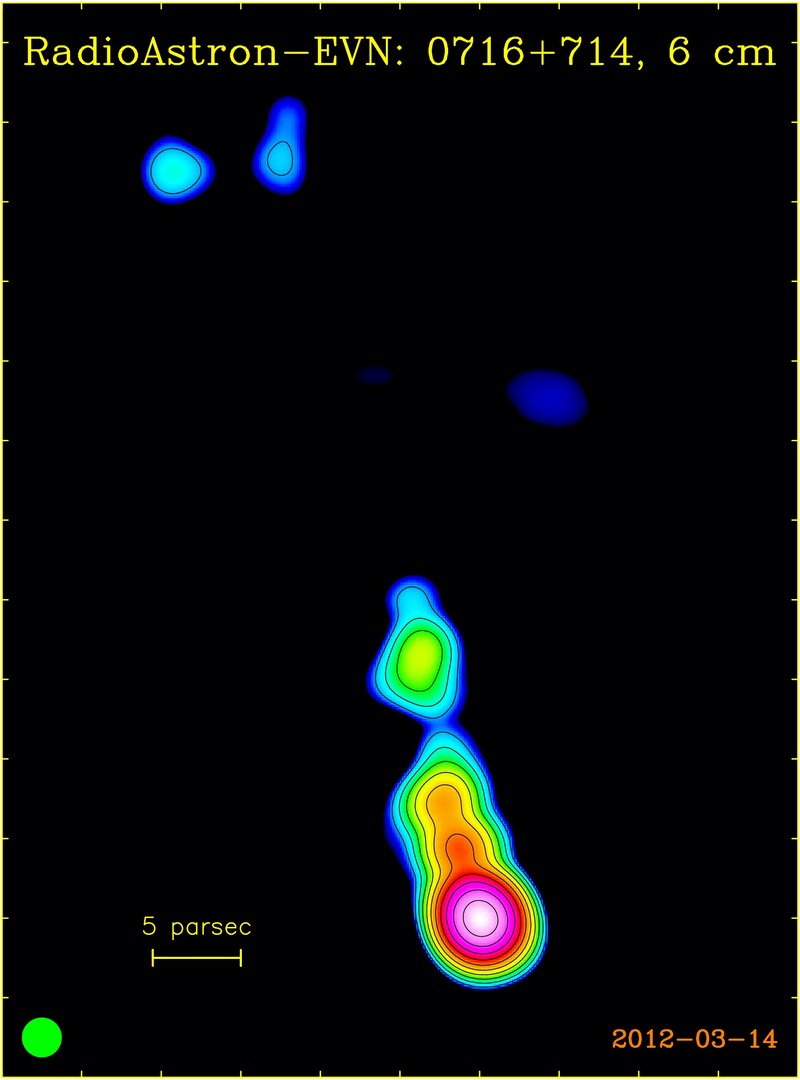
Image prepared by ASC LPI
To compare the capabilities of RadioAstron and its predecessors, terrestrial interferometers with a super-long base, I combined the images taken by the American VLBA network (Very Long Baseline Array).

The higher resolution of RadioAstron makes the image of the quasar's core smaller, since it reveals precisely its details, and not the background that sees the VLBA.
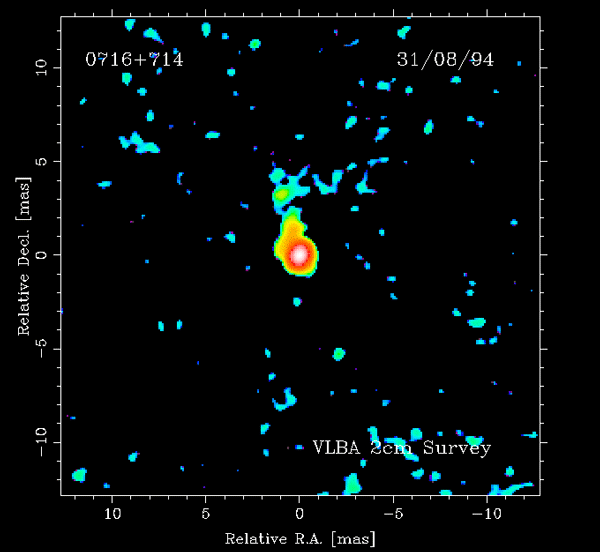
Another direction of the telescope in the study of quasars is the registration of the radiation temperature of their nuclei or, in other words, their brightness. This search is important for understanding the physics of jet radiation. The current popular model explaining the formation of relativistic jets suggests that it is a stream of very fast electrons. If this is the case, then the flux should have a brightness in a strictly defined range - no more than a certain limit value. However, there is an alternative theory which suggests that relativistic protons can emit in these flows. And protons are 1000 times heavier than electrons, respectively, for their "launch" it takes much more energy and the brightness of the jets will be much higher. And in order to explain this energy, scientists will have to revise very many prevailing views on the physics of quasars, so the "proton" hypothesis to astrophysicists is not comfortable. But it is not possible to confirm or disprove it from the Earth due to insufficient resolution of ground-based interferometers.
Radioastron conducted successful observations of several dozens of quasars and the results of its observations already fit into the modern popular model of jets. At the same time, as the duration of work, the quality and range of observations increases, because in its work Radioastron incrementally increases the size of the base of the interferometer, and the data will still arrive and discover new details and properties of the Universe.
Another significant contribution to science "Radioastron" makes studying pulsars . Pulsars - neutron stars - “sub-holes”. Microscopic, on a scale of stars, objects with neutron matter of the highest density. For example, a pulsar of one and a half times the mass of the Sun can be 10 km in diameter and rotate at a speed of up to 700 revolutions per second. The peculiarity of the pulsar, according to which it was named, is the high frequency of pulses in the radio or X-ray range recorded from the Earth. When scientists first recorded such a radio signal, they decided that it was an alien beacon. The first pulsar was discovered in 1967 and received the working title LGM-1 - abbr. from Little Green Men.
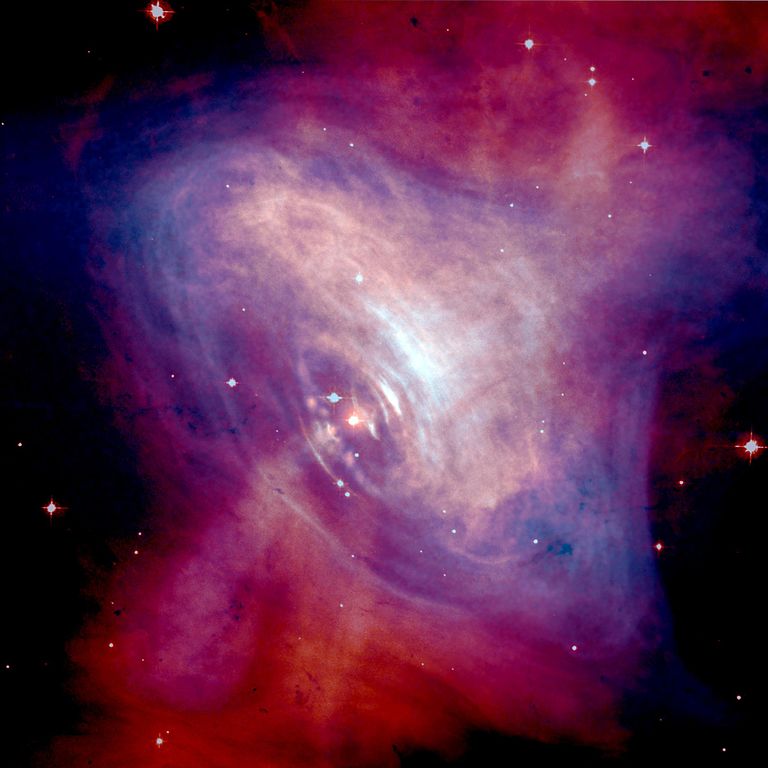
Crab Nebula with a pulsar in the center.
By July 2013, 2,267 pulsars were open, constantly detecting new ones, but only Radioastron can “get closer” to everything. Although preliminary calculations did not promise anything promising - they threatened with the same interstellar “fog”.
With pulsars associated with two main areas of the project.
First, the use of a bright and compact pulsar for scanning the interstellar medium and studying its properties.
Second: the localization of the source of radiation of the pulsar. Pulsar "works" on the principle of a car flashing light. One impulse is one revolution of a pulsar and one flash that reaches us from a certain source of a neutron star generated by a magnetic field. But what is this source is not yet known. According to the generally accepted theory, radiation sources are located at the magnetic poles of the pulsar, i.e. these are such “radio jets” (the term is not scientific, I thought up to show similarities with quasars, where jets are also formed by a magnetic field). Pulses occur if the geographic pole of the pulsar does not coincide with the magnetic one, and the “radiojet” describes a circle, like a searchlight, for each revolution of the body around its axis. When such a searchlight "illuminates" the Earth, our radio telescopes register a radio pulse. Read more about radio pulsars .

But scientists do not exclude the other nature of the pulses, therefore, to determine accurately, it is necessary to observe the pulsar with the highest resolution. And with the one that even Radioastron will not provide. But the device can be used to master an even more advanced method of research: to use an interstellar plasma as an interferometer. If this happens, a resolution will be achieved that would provide a "plate" with a diameter of ... 10 billion kilometers - from the solar system. Nothing of the kind in history has yet been accomplished, but there is a theoretical basis for such an attempt - it remains only to try. And no device other than Spectr-R today will allow such an experiment. Scientists say: “Analysis started. There are no results yet, but we wait with hope. ”
Observations on the early scientific program ended in June 2013, and since July, i.e. just a couple of weeks ago, the so-called open key scientific program started. From the very first days of the project, its activities were international in nature. Almost all the largest radio telescopes of the world participate in it. Therefore, Radioastron is open to applications from the entire international community, including, of course, Russia. In the first year of the open program, applications were sent by more than 30 scientific groups from around the world from more than 200 co-authors - about half of all radio astronomers of the planet who deal with issues of superlong-base interferometry.
There are several promising areas of research for Radioastron:
1. The nuclei of active galaxies (quasars), the measurement of brightness, size, internal structure, the study of the immediate vicinity of supermassive black holes.
2. Mapping of jets of galaxies.
3. Pulsars, characteristics and structure of the interstellar medium.
4. Areas of formation of stars and planets.
For the first year of work in the framework of an open competition, seven key projects were selected, astronomers of Russia lead or participate in the implementation of each of these programs.
In all directions, the telescope can conduct research like no other device on Earth. In fact, thanks to the Spectrum-R, Russia made a huge leap forward, at least in a narrow direction, and turned out to be the undisputed leader in world radio astronomy. She is like Galileo with her telescope, ready to let everyone see through it, but no one else has it.

Of course, not everything is perfect in such a complex project. There are technical problems of the device, and difficulties in ensuring the ground component of the work. Officially, no one talks about this to the public, so rumors roam one worse than the other. It is possible that there are some grounds under them, but to retell them is only to multiply. Let Roscosmos learn sincerity. When foreign scientists were invited to work, they were honestly told everything. But, as you can see, they keep the information to themselves. The device works, science does - this is important.
But on-site RAS and Roskosmos I would go right now to ask for money for Radioastron-2. Now NPO Lavochkina is going to build the next breakthrough apparatus Millimetron, but Radioastron-2, with corrected children's diseases and an increased resource, would permanently consolidate Russia's position in world astrophysics. And it would not have had to be built for 30 years, since it remained a reserve for the first device. Just as NASA is currently building a new rover based on Curiosity, it is almost twice as cheap. Although the RAS now seems to be not up to space expansion, but I hope for the best.
In any case, we will monitor the activities of our apparatus, and talk about the results.

After the first observations, a year and a half has passed. All this time the telescope was occupied by an early scientific program. In fact, the first studies consisted in the fact that scientists determined the limits of the capabilities of RadioAstron and set such scientific tasks that were of high scientific importance and the probability of success. This program was coordinated by the Astro-Cosmic Center (ASC) of FIAN, the program manager Yu.Yu. Kovalev, performed by international groups of scientists with the leading role of the ASC.
Yury Yuryevich helped in the preparation of this material, for which he thanks a lot.
')
What did scientists learn during the work of the Radioastron project?
Firstly, they learned the capabilities of their apparatus, and secondly, they learned what knowledge, in the future, are able to provide these opportunities.
If someone has difficulties with understanding the work of Radioastron, I recommend reading the previous article on this topic, where I tried to explain the basic principles of radio interferometry with super-long bases.
In the course of scientific research, scientists build theoretical models, or simply reasonable assumptions, which are designed to fill gaps in knowledge. These models are based on already known facts and mathematical calculations, and each newly discovered fact makes it possible to double-check the accuracy of the model and the accuracy of the calculations. So, theoretical models made it possible to predict what results Radioastron would produce on bases up to 10 Earth diameters - about 130 thousand km. What will happen next, no model could predict - it could only be verified.

Scheme expert.ru ( large size on the site ).
There were several questions. The first is in the brightness and compactness of distant galaxies. If the nuclei of galaxies are not compact enough, with a high angular resolution of Radioastron, we would not “see”. One noise. The second important question is in the properties of the interstellar medium - its density and structure. Despite the illusion of emptiness, almost all the space in our Galaxy is filled with gas and dust. Although their share is insignificant, at large distances they begin to affect the radio emission passing through them like the earth's atmosphere. This effect is the stronger the longer the wave on which the observation is made. It was assumed that compact objects, which are still possible to distinguish at a length of 1.3 and 6 cm, at 18 and 92 cm will already appear blurry. Just as you can take an optical telescope of any power, but in the fog, he still does not see anything.
The early scientific program received positive results, for a wave of 92 cm, on the bases of an interferometer with a distance of up to 20 Earth diameters (that is, two times better than predicted).

This is the very signal. Please note that the Spektr-R space telescope practically does not register a pulse, but paired with Arecibo, they give a clearer signal, i.e. provide higher resolution, which is the meaning of the project "Radioastron".
Image prepared by ASC LPI
For a wave of 18 cm, data were obtained at a distance of up to 16 Earth diameters. 19 diameters for a wave of 16 cm and 8 diameters on a wave of 1.3 cm. It does not even matter what the results were at these distances, how much the distances themselves are. Waited "fog", but it was not there. More precisely, the fog was, but not with the properties, as predicted by the theory. Not at all the structure.
A separate subject of pride of our astrophysicists and engineers is the angular resolution, which they received at a wavelength of 1.3 cm at the bases of the ground-space interferometer in 8 diameters of the Earth. The result is 27 microseconds of arc or angular microseconds. This is the highest resolution that has been obtained by any instruments in the entire history of human observations of the Universe. To better understand the magnitude of this figure, compare with the results of Hubble. Let me remind you that its resolution is 0.05 arc seconds. Radioastron showed 0.000027.

But one cannot oppose these two instruments, since they are too different. They work in different ranges, and on different principles build images. Therefore, to say “Radioastron is cooler than Hubble”, is equivalent to the phrase: “Our crane is faster than their bulldozer”. Figuratively telescopes can be compared with construction equipment: each device is busy with its own business, but together they build one road to knowledge.
Now, about the results of observations .
Radioastron dedicated much of its working time to quasars. Quasars are high density, active galaxies that form around supermassive black holes. The light of an accretion disk (usually studied in the X-ray range) reaches us, in which stars and interstellar gas gather under the action of the force of attraction of a black hole. Under the pressure in the disk, colossal energy is released, which we perceive as electromagnetic radiation. Internal processes form the most powerful jets of matter from the poles of rotating black holes. These flows are called jets or relativistic jets, since the speed of propagation of matter from them comes close to the speed of light, which is possible only when exposed to the most powerful energy.

Quasars are located at significant distances of billions of light years from us. If they were at least millions of light years away, the nights would be much brighter. But I wouldn’t regret the remoteness of quasars - if the Solar System got into the jet, it would quickly disinfect it and no bunkers would save us.

This is not a quasar, but a jet from the center of one of the largest galaxies M87 . Photo Hubble.
Quasars discovered in the late 50s. Twentieth century, but today scientists are wondering what is happening in their center.
According to the speed of variability of their brightness, it was suggested that the core of one of the active galaxies should be no larger than the solar system, but they could not determine the exact scales before. Until Radioastron arrived.
In general, the variability of the brightness of a quasar can also arise from reasons beyond its control — for example, from a gas-dust cloud that lies between us and it. But if it flickers at the same time in all or in several ranges, then internal causes are most likely. One of these objects, whose radiation variability in the optical and radio bands coincided, had previously been carefully observed from the Earth and concluded that it was not about interplanetary dust, but internal processes.
It was him who was chosen as a "shooting" for "Radioastron". Quasar 0716 + 714 was the first active galaxy mapped with the highest accuracy previously unavailable. It turned out that the diameter of the "nozzle" from which the relativistic jet takes off is about one light year. It is curious that these observations disproved the early hypothesis that the rapid variability of the radiation of the galactic nucleus is associated with internal processes. That is, once again, “Radioastron” violated the early model and forced scientists to look for another solution.

Image prepared by ASC LPI
To compare the capabilities of RadioAstron and its predecessors, terrestrial interferometers with a super-long base, I combined the images taken by the American VLBA network (Very Long Baseline Array).

The higher resolution of RadioAstron makes the image of the quasar's core smaller, since it reveals precisely its details, and not the background that sees the VLBA.

Another direction of the telescope in the study of quasars is the registration of the radiation temperature of their nuclei or, in other words, their brightness. This search is important for understanding the physics of jet radiation. The current popular model explaining the formation of relativistic jets suggests that it is a stream of very fast electrons. If this is the case, then the flux should have a brightness in a strictly defined range - no more than a certain limit value. However, there is an alternative theory which suggests that relativistic protons can emit in these flows. And protons are 1000 times heavier than electrons, respectively, for their "launch" it takes much more energy and the brightness of the jets will be much higher. And in order to explain this energy, scientists will have to revise very many prevailing views on the physics of quasars, so the "proton" hypothesis to astrophysicists is not comfortable. But it is not possible to confirm or disprove it from the Earth due to insufficient resolution of ground-based interferometers.
Radioastron conducted successful observations of several dozens of quasars and the results of its observations already fit into the modern popular model of jets. At the same time, as the duration of work, the quality and range of observations increases, because in its work Radioastron incrementally increases the size of the base of the interferometer, and the data will still arrive and discover new details and properties of the Universe.
Another significant contribution to science "Radioastron" makes studying pulsars . Pulsars - neutron stars - “sub-holes”. Microscopic, on a scale of stars, objects with neutron matter of the highest density. For example, a pulsar of one and a half times the mass of the Sun can be 10 km in diameter and rotate at a speed of up to 700 revolutions per second. The peculiarity of the pulsar, according to which it was named, is the high frequency of pulses in the radio or X-ray range recorded from the Earth. When scientists first recorded such a radio signal, they decided that it was an alien beacon. The first pulsar was discovered in 1967 and received the working title LGM-1 - abbr. from Little Green Men.

Crab Nebula with a pulsar in the center.
By July 2013, 2,267 pulsars were open, constantly detecting new ones, but only Radioastron can “get closer” to everything. Although preliminary calculations did not promise anything promising - they threatened with the same interstellar “fog”.
With pulsars associated with two main areas of the project.
First, the use of a bright and compact pulsar for scanning the interstellar medium and studying its properties.
Second: the localization of the source of radiation of the pulsar. Pulsar "works" on the principle of a car flashing light. One impulse is one revolution of a pulsar and one flash that reaches us from a certain source of a neutron star generated by a magnetic field. But what is this source is not yet known. According to the generally accepted theory, radiation sources are located at the magnetic poles of the pulsar, i.e. these are such “radio jets” (the term is not scientific, I thought up to show similarities with quasars, where jets are also formed by a magnetic field). Pulses occur if the geographic pole of the pulsar does not coincide with the magnetic one, and the “radiojet” describes a circle, like a searchlight, for each revolution of the body around its axis. When such a searchlight "illuminates" the Earth, our radio telescopes register a radio pulse. Read more about radio pulsars .

But scientists do not exclude the other nature of the pulses, therefore, to determine accurately, it is necessary to observe the pulsar with the highest resolution. And with the one that even Radioastron will not provide. But the device can be used to master an even more advanced method of research: to use an interstellar plasma as an interferometer. If this happens, a resolution will be achieved that would provide a "plate" with a diameter of ... 10 billion kilometers - from the solar system. Nothing of the kind in history has yet been accomplished, but there is a theoretical basis for such an attempt - it remains only to try. And no device other than Spectr-R today will allow such an experiment. Scientists say: “Analysis started. There are no results yet, but we wait with hope. ”
Observations on the early scientific program ended in June 2013, and since July, i.e. just a couple of weeks ago, the so-called open key scientific program started. From the very first days of the project, its activities were international in nature. Almost all the largest radio telescopes of the world participate in it. Therefore, Radioastron is open to applications from the entire international community, including, of course, Russia. In the first year of the open program, applications were sent by more than 30 scientific groups from around the world from more than 200 co-authors - about half of all radio astronomers of the planet who deal with issues of superlong-base interferometry.
There are several promising areas of research for Radioastron:
1. The nuclei of active galaxies (quasars), the measurement of brightness, size, internal structure, the study of the immediate vicinity of supermassive black holes.
2. Mapping of jets of galaxies.
3. Pulsars, characteristics and structure of the interstellar medium.
4. Areas of formation of stars and planets.
For the first year of work in the framework of an open competition, seven key projects were selected, astronomers of Russia lead or participate in the implementation of each of these programs.
In all directions, the telescope can conduct research like no other device on Earth. In fact, thanks to the Spectrum-R, Russia made a huge leap forward, at least in a narrow direction, and turned out to be the undisputed leader in world radio astronomy. She is like Galileo with her telescope, ready to let everyone see through it, but no one else has it.

Of course, not everything is perfect in such a complex project. There are technical problems of the device, and difficulties in ensuring the ground component of the work. Officially, no one talks about this to the public, so rumors roam one worse than the other. It is possible that there are some grounds under them, but to retell them is only to multiply. Let Roscosmos learn sincerity. When foreign scientists were invited to work, they were honestly told everything. But, as you can see, they keep the information to themselves. The device works, science does - this is important.
But on-site RAS and Roskosmos I would go right now to ask for money for Radioastron-2. Now NPO Lavochkina is going to build the next breakthrough apparatus Millimetron, but Radioastron-2, with corrected children's diseases and an increased resource, would permanently consolidate Russia's position in world astrophysics. And it would not have had to be built for 30 years, since it remained a reserve for the first device. Just as NASA is currently building a new rover based on Curiosity, it is almost twice as cheap. Although the RAS now seems to be not up to space expansion, but I hope for the best.
In any case, we will monitor the activities of our apparatus, and talk about the results.
Source: https://habr.com/ru/post/186978/
All Articles